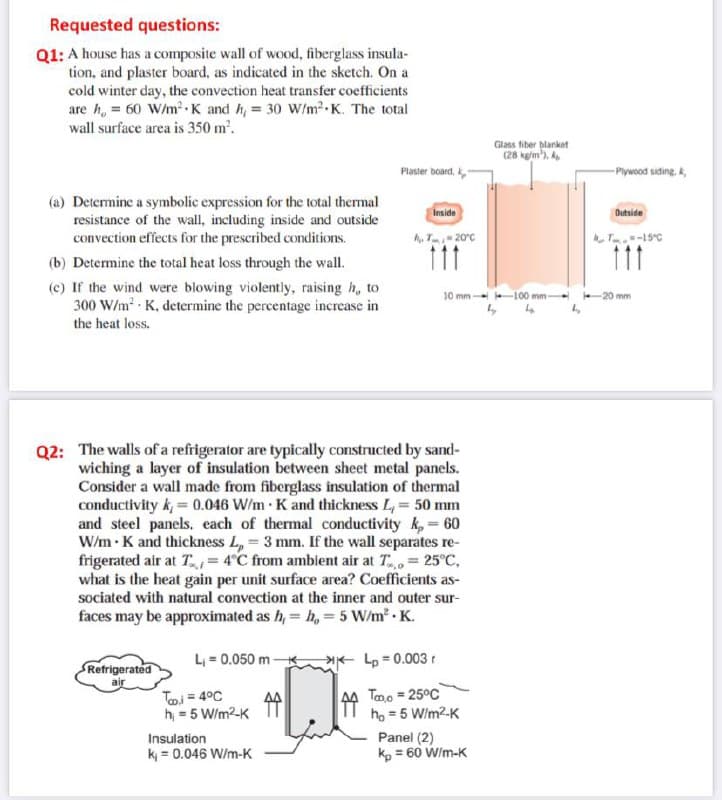Q1: A house has a composite wall of wood, fiberglass insula- tion, and plaster board, as indicated in the sketch. On a cold winter day, the convection heat transfer coefficients are h, = 60 W/m.K and h, = 30 Wf/m²-K. The total wall surface area is 350 m'. Glass fiber blarket (28 kgm'), A Plaster board. -Piywood siding. A, (a) Determine a symbolic expression for the total thermal resistance of the wall, including inside and outside convection effects for the prescribed conditions. Inside Datside 4.T 20°c 11 111 (b) Determine the total heat loss through the wall. (c) If the wind were blowing violently, raising h, to 300 W/m K, determine the percentage increase in the heat loss. 10 mm 100 mm 20 mm
Q1: A house has a composite wall of wood, fiberglass insula- tion, and plaster board, as indicated in the sketch. On a cold winter day, the convection heat transfer coefficients are h, = 60 W/m.K and h, = 30 Wf/m²-K. The total wall surface area is 350 m'. Glass fiber blarket (28 kgm'), A Plaster board. -Piywood siding. A, (a) Determine a symbolic expression for the total thermal resistance of the wall, including inside and outside convection effects for the prescribed conditions. Inside Datside 4.T 20°c 11 111 (b) Determine the total heat loss through the wall. (c) If the wind were blowing violently, raising h, to 300 W/m K, determine the percentage increase in the heat loss. 10 mm 100 mm 20 mm
Principles of Heat Transfer (Activate Learning with these NEW titles from Engineering!)
8th Edition
ISBN:9781305387102
Author:Kreith, Frank; Manglik, Raj M.
Publisher:Kreith, Frank; Manglik, Raj M.
Chapter1: Basic Modes Of Heat Transfer
Section: Chapter Questions
Problem 1.42P
Related questions
Question

Transcribed Image Text:Requested questions:
Q1: A house has a composite wall of wood, fiberglass insula-
tion, and plaster board, as indicated in the sketch. On a
cold winter day, the convection heat transfer coefficients
are h, = 60 W/m K and h, = 30 W/m2 K. The total
wall surface area is 350 m'.
Glass fiber blanket
(28 kg/m'), A
Plaster board,
- Plywood siding. k,
(a) Determine a symbolic expression for the total thermal
resistance of the wall, including inside and outside
convection effects for the prescribed conditions.
Inside
Outside
A, T20°c
T-15°C
111
(b) Determine the total heat loss through the wall.
(c) If the wind were blowing violently, raising h, to
300 W/m K, determine the percentage increase in
10 mm 100 mm-
- 20 mm
the heat loss.
Q2: The walls of a refrigerator are typically constructed by sand-
wiching a layer of insulation between sheet metal panels.
Consider a wall made from fiberglass insulation of thermal
conductivity k, = 0.046 W/m K and thickness L, = 50 mm
and steel panels. each of thermal conductivity k, = 60
W/m K and thickness L, = 3 mm. If the wall separates re-
frigerated air at T = 4°C from ambient air at T= 25°C,
what is the heat gain per unit surface area? Coefficients as-
sociated with natural convection at the inner and outer sur-
faces may be approximated as h, = h, = 5 W/m · K.
L = 0.050 m
Lp = 0.003r
Refrigerated
Toi = 4°C
h = 5 W/m2-K
44 Tmo = 25°C
ho = 5 W/m2-K
Panel (2)
kp = 60 W/m-K
Insulation
k = 0.046 W/m-K
Expert Solution
This question has been solved!
Explore an expertly crafted, step-by-step solution for a thorough understanding of key concepts.
This is a popular solution!
Trending now
This is a popular solution!
Step by step
Solved in 4 steps

Knowledge Booster
Learn more about
Need a deep-dive on the concept behind this application? Look no further. Learn more about this topic, mechanical-engineering and related others by exploring similar questions and additional content below.Recommended textbooks for you

Principles of Heat Transfer (Activate Learning wi…
Mechanical Engineering
ISBN:
9781305387102
Author:
Kreith, Frank; Manglik, Raj M.
Publisher:
Cengage Learning

Principles of Heat Transfer (Activate Learning wi…
Mechanical Engineering
ISBN:
9781305387102
Author:
Kreith, Frank; Manglik, Raj M.
Publisher:
Cengage Learning